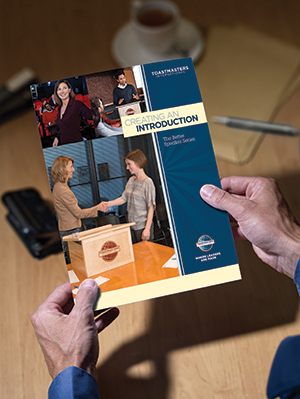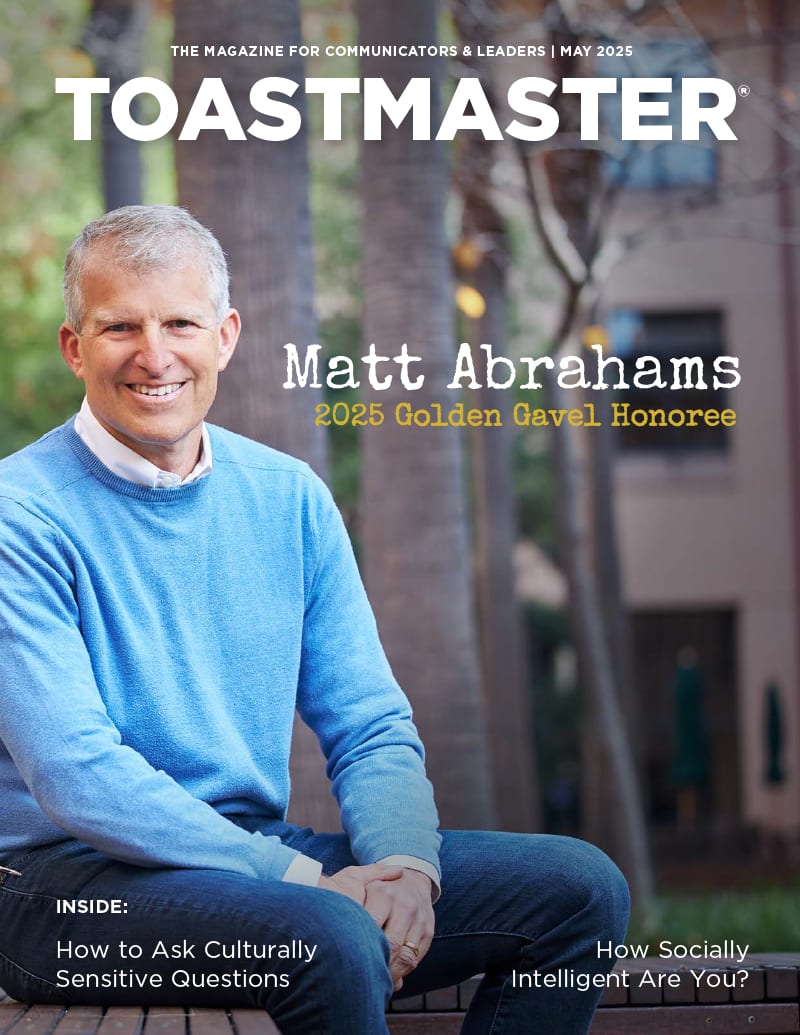As a professional speaker, I’m often introduced to the audience by someone who doesn’t know me. How do you introduce a speaker to an audience?
It’s an important job, says speaker and humorist Christine Holton Cashen, a Certified Speaking Professional (CSP). “A good introduction is more than your background,” she says. “It can affect how the entire audience receives your message.”
This also applies to non-speech situations, when you are introducing yourself to other people. What do you say when someone says, “So, tell me about yourself.” Where do you start? While we all are experts on the topic of ourselves, we’re not very good at introducing ourselves. The question “So what do you do?” is most often answered with something like “I’m an accountant” or “I’m in sales.”

Business expert Michael Port, bestselling author of Book Yourself Solid, advises against this. He writes, “We hear the What do you do for a living? question all the time. Your professional category alone is the wrong answer, because that is talking at people, instead of with them.” Instead, he suggests using dialogue to build relationships.
How to Introduce Yourself
These six tips can help you become an expert at introducing yourself so you can make richer connections, build relationships and enjoy more personal and professional growth.
Create a plan.
A social event, like a wedding or party, is different from a professional event, where you’re more focused on growing your business or expanding your influence. Social events are for fun, although you may make some business contacts. Before attending an event, decide on your goal.
Networking expert Dan Toussant, DTM, is owner of Dan Toussant & Associates, an executive recruiting firm, and managing director of The Interview Doctor, a business consulting company. He believes planning is essential. “Know what to say about yourself and write it down ahead of time,” he says. “Include basic facts, something catchy, brief and even humorous. Have a quick synopsis of your experience and a unique value-added point. These conversations are two-way.”
Toussant, a member of the Stark Community Toastmasters and Hall Of Fame Advanced Speakers, both in Canton, Ohio, suggests that you help the dialogue and increase the energy by interrupting your introduction and asking, “Would you like me to continue?” or “Have I answered your question?” He recommends that you practice often and get feedback to sound more natural and avoid feeling scripted. Toastmasters know about feedback! Ask your club for it. Make it a Table Topic.
Use common courtesies.
- Smile! In his book How to Win Friends and Influence People, Dale Carnegie devotes an entire chapter to smiling. It communicates approachability.
- Stand tall. Look at people, not your phone. Keep your handshake hand free and dry; hold your cold drink in your other hand.
- Have a name tag? Make sure it’s visible and high enough so people aren’t scanning your belly to read it.
- Offer a firm handshake, make solid eye contact and use a strong voice.
Cultivate relationships.
No matter how many social media contacts you have, or how much marketing you do, face-to-face encounters are still the best paths to professional growth. Focus on providing value to people by telling them what you can offer instead of extracting a benefit from them. Be attentive and interested in them. Don’t try to impress them. In his book, Carnegie outlines six ways to get people to like you. None includes impressing them.
Be curious.
Develop an intense curiosity about other people. Without being nosy, you can ask polite questions that show sincere interest. Phrases like I’d love to learn more or What brought you here? show curiosity. Get others talking about themselves. This may sound counter-intuitive if you want to introduce yourself, but their story may lead into yours, which leads to an easier introduction.
Kinetta Johnson, ACB, ALB, of the Dulles South club in Stone Ridge, Virginia, says, “When I first meet someone, I spend most of my time drawing them out with open-ended questions. I listen to their responses, reflect the theme and emotions, and find opportunities to intentionally connect and continue the dialogue.”
Communicate your contribution.
An introduction is more than just a name and title. You want to communicate your contribution, or how you can serve people. Gary McKinsey, ACB, CL, frequently speaks to groups about effective networking. He suggests using a “curiosity statement,” a phrase you weave into a conversation to communicate value and stimulate more dialogue.

McKinsey, a member of ToastBreakers Toastmasters in Modesto, California, recently attended a networking mixer and approached a man standing by himself. After extending his hand and exchanging names, McKinsey asked the man if he’d attended mixers before. “Yes,” the man replied. “Actually, I’m the host tonight.” McKinsey responded by saying, “Wonderful! Tell me about your business.” As the two conversed, the man asked McKinsey about his work. “Instead of stating my title,” McKinsey says, “I replied with my curiosity statement. I work with businesses to increase their profits and help them avoid expensive and time-consuming mistakes. The man said, ‘Let’s talk!’ We now have an appointment.”
This underscores the planning recommended by Dan Toussant. Develop a curiosity statement for yourself. Who do you help and how do they benefit? You’re a lawyer? You help people maneuver through legal mazes so they come out safe and sane. You’re a plumber? You worry about water pipes so homeowners don’t have to.
Be conversational.
Speak as you would in conversation. Don’t sound robotic or scripted. Be warm and relaxed. Too many introductions start out warm, but flip into machine-like precision, sounding very cold.
Let the conversation flow. As a leadership consultant with the global firm Hay Group, Aditya Maheswaran, DTM, coaches CEOs and managers on networking. He placed second in the 2015 Toastmasters World Championship of Public Speaking. Instead of using a scripted introduction, let the conversation flow based on the occasion, advises Maheswaran. “Put the other person first,” he says. “Saying I am a consultant, nice to meet you doesn’t work. Saying, I noticed that you are interested in leadership books—maybe I can help? is far better.”
An audience-focused introduction is significantly more interesting than a cut-and-paste bio.
Some things are better read than said. Avoid overly comical or cutesy introductions. They may sound brilliant, but they build walls, not relationships. These kinds of introductions may look great on paper, but if they don’t feel conversational when you say them, they won’t sound conversational when someone hears them.
But humor can help, as long as it’s not corny. Kenneth Lee, ATMG, CL, of Hervey Bay Toastmasters in Queensland, Australia, always gets a smile with his introduction: I am an actor and an income tax advisor. As an actor, my other profession has been of no use; however, as a tax advisor, my acting has been invaluable.
Avoid jargon or unusual terms that are unfamiliar to others. As a former NASA engineer, I could say, I conducted evaluative comparisons on air-breathing propulsion systems to determine the performance deltas. Huh? A better sentence is: I did research on airplane engines.
When You Are the Introducer
How do you introduce people, whether they are giving a speech or meeting at a social or work event? When the occasion calls, are you unsure of what to do? Extending introductions is very different from introducing yourself, but with some tips you can master this art as well.
 Learn more about the art of introduction from the Toastmasters manual Creating an Introduction, available from the Toastmasters online store.
Learn more about the art of introduction from the Toastmasters manual Creating an Introduction, available from the Toastmasters online store.Introducing a Speaker to an Audience
Introducing a stranger can feel awkward. When someone introduces me as a speaker, I want that person to look good and feel comfortable. I also want the audience to be primed for my presentation, so I write my own introduction. I don’t use my website bio. I’m sure you’ve listened to a long and impressive list of a speaker’s credentials and thought, That’s nice. What’s in this for me? A more effective introduction is one that makes a strong connection with the audience, and promises there’s something of value for them.
Cashen, the speaker/humorist, has crafted a wildly effective template for a speaker introduction that focuses more on the audience than on the speaker. Her template creates a script for the introducer to use that makes them feel more confident. The script includes some of the speaker’s credentials, some personal rapport-building information, some humor and a few questions to ask the audience that hint about what they will learn. For example, suppose Jamie Ballace speaks to nail salon owners about employee retention. Here’s a script she could give to her introducer.
Jamie Ballace Intro
“Let’s begin with a few questions.
- Would you like lower employee turnover?
- Do you want to energize your employees?
- Are you ready for tips to make your salon a great place to work?
If you answered yes, then you’re in the right place! Our speaker today owns five nail salons and has 50 employees and less than 10 percent turnover. She’s opened a new salon each year for three years, with plans for five more.
When not working, she can be found doing Zumba or getting pedicures from her 4-year-old daughter. Helping us today to Create a Stellar Culture, please help me welcome from Pinckney, Michigan… speaker, author, and unashamed lover of Hallmark movies—Jamie Ballace!”
See the difference? An audience-focused introduction is significantly more interesting than a cut-and-paste bio. Try it! Maybe arrange a club meeting where every member crafts and delivers their own audience-focused introduction.
Introducing People to Each Other
When at a party or networking event, you’ve probably introduced two people you know to each other. Debbie Forbes, ACG, ALB, of the Positive Thinkers Toastmasters in Vancouver, British Columbia, Canada, points out a different approach to use when introducing another person, as compared to introducing yourself. “At a party,” she says, “you introduce yourself by name, and perhaps include how you know the host. When introducing another person, you have freedom to brag about them, or mention things the two have in common.” It’s actually quite fun to boast about someone else.

Who do you start with? Many people are confused by the order of introductions. It boils down to this: Speak first to the person you wish to honor. Grandma, I’d like you to meet my neighbor Karen. Then turn to Karen and say, Karen, this is my grandmother, Anna Jones.
Who do you honor first? Most often, order is determined by age, rank, title and relationship. Address the older before the younger, your friend before a family member, a client before any co-worker (including a CEO) and a titled or ranked person (senator, reverend, doctor, etc.) before a contemporary.
All introductions serve two common goals: to make people comfortable and cultivate a relationship. To create a comfortable encounter, ask yourself, How can I put this person or group first? Even a speaker addressing an audience must establish a warm rapport in order to have the privilege of communicating a message. Use your Toastmasters club meetings to work on these skills. In no time, you’ll master the art of any introduction
Maureen Zappala, DTM, AS is a former NASA propulsion engineer. Today she’s a professional speaker, author and presentation skills coach, as well as founder of High Altitude Strategies, a coaching and speaking service. Visit her website to learn more.




 How to Introduce a Speaker
How to Introduce a Speaker
 Previous Article
Previous Article